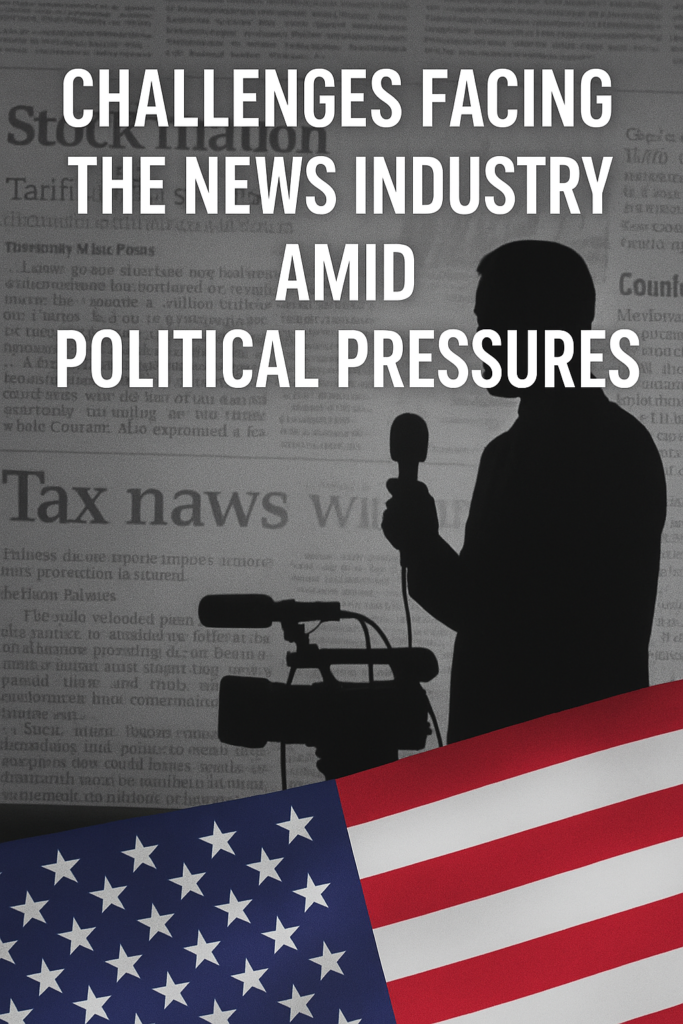Under Pressure: The News Industry’s Struggle Amid Political Turbulence
In the age of digital disruption and deepening political divides, the news industry stands at a critical crossroads. Once the watchdogs of democracy and the fourth estate of accountability, media organizations today find themselves under siege—not just economically, but ideologically. Nowhere was this crisis more visible than during the Trump administration, a time marked by rising hostility toward journalists, economic upheaval, and fractured trust in the media.
This blog post unpacks the forces reshaping the journalism landscape, explores the broader implications for democracy, and offers a way forward.
The Collapse of Traditional Revenue Models
For decades, newspapers and broadcast outlets operated under a relatively stable business model powered by advertising. But with the rise of digital platforms like Google and Facebook, those revenue streams have evaporated. Between 2008 and 2020, U.S. newspaper advertising revenue plummeted by over 70%, according to the Pew Research Center. Many legacy newsrooms have struggled to adapt to this digital-first ecosystem, where tech giants dominate ad dollars and audience attention.
The Trump era added further strain. While the administration did not enact direct media policy changes, its rhetorical hostility toward journalists created a chilling effect. Instead of supporting innovation or local news transitions, the government often ignored—or inflamed—the sector’s vulnerabilities.
“Enemy of the People”: How Rhetoric Damaged Trust
One of the most disturbing trends of the Trump years was the repeated labeling of the press as “fake news” and “the enemy of the people.” These attacks weren’t just symbolic—they were systematic efforts to delegitimize critical coverage and sow doubt about the role of a free press in American society.
The impact? A 2020 Gallup/Knight Foundation survey showed only 41% of Americans had a “great deal” or “fair amount” of trust in the media, down from 55% in 2000. This erosion of trust is dangerous in any democracy. Without confidence in news institutions, public discourse becomes vulnerable to manipulation, misinformation, and partisan extremism.
Echo Chambers and a Divided Media Ecosystem
During the Trump presidency, the media landscape became more polarized than ever. Audiences retreated into ideological echo chambers: conservative viewers gravitated toward Fox News, Newsmax, and OANN, while liberals tuned into CNN, MSNBC, and progressive outlets.
This divide has had real consequences. With fewer people exposed to differing perspectives, compromise becomes harder, and polarization deepens. The rise of partisan media ecosystems has also fueled misinformation, especially when amplified through unchecked social media algorithms.
The Slow Death of Local Journalism
Perhaps the most heartbreaking casualty of this transformation is local news. Thousands of local newspapers have either closed or significantly downsized in the past two decades. The financial instability of community journalism has resulted in “news deserts”—regions with little to no original local reporting.
Research shows that the decline of local watchdog journalism correlates with lower civic engagement and higher rates of government corruption. When local newspapers disappear, so do the public’s eyes and ears on school boards, city councils, and municipal budgets.
A Path Forward: Rebuilding Trust and Sustainability
Despite these challenges, hope is not lost. Revitalizing the press requires a multi-pronged strategy grounded in public-private innovation, educational investment, and a recommitment to democratic values.
1. Support Independent Journalism
Governments, philanthropies, and private investors must collaborate to create sustainable business models for independent media. This could include:
-
Tax incentives for subscriptions
-
Grants for investigative journalism
-
Expanding nonprofit newsroom models
2. Invest in Media Literacy
An informed public is the best defense against misinformation. We must equip citizens—especially young people—with the tools to critically evaluate information. Media literacy education should be a standard part of school and college curricula nationwide.
3. Protect First Amendment Norms
Leaders must reaffirm the role of a free press in a healthy democracy. Political rhetoric matters. Elected officials should model respect for journalistic institutions—even in disagreement—and reject language that undermines them.
4. Hold Digital Platforms Accountable
Social media companies have become the primary distributors of news for millions. It’s time to demand greater transparency in how their algorithms work, especially around political content. Policies should promote accountability without infringing on free speech or platform innovation.
Conclusion: Journalism is Democracy’s Immune System
In many ways, journalism is the immune system of democracy—fighting off corruption, misinformation, and abuse of power. But just like any immune system, it needs nourishment, support, and protection to do its job.
The Trump era exposed the vulnerabilities of the modern news industry, but it also underscored its importance. As we move forward, the question is not whether journalism can survive—but whether we as a society are willing to defend it.Because without a free and trusted press, democracy itself begins to wither.
Check out the GTF Research
Check out events
Connect with us on facebook
connect with us on linkedIn
Check out the American Transformation forum
